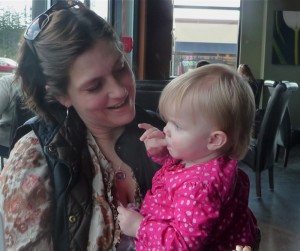This is the 2011 June Island Parent magazine profile of the JDRF youth Ambassadors I wrote. Over the next few weeks I’ll put up profiles from previous years.
The first years of introducing an infant to the world have special challenges. In those precious first few months a new mother finds herself second guessing every cough or sniffle: is it diaper rash or an allergic reaction?
There are the obvious moments, when the baby spikes a fever or projectile vomits across the room. There is no special knowledge needed at that point to reach for the car keys and head to the hospital. But what if the baby is breast feeding more frequently, always hungry and soaking through more diapers than maybe she did the week before. Is this just another growth spurt or is it just the sleep deprivation talking, dear. You’ll feel better after you have a nap.
A week before Christmas, 2010, 11 month old Tula Stanley, who never napped, suddenly wanted to lie down in the middle of the day. When she woke 3 hours later she didn’t want to eat and began to vomit. Wondering if it might just be a bug Samantha waited till the next morning. Tula was still sick the next morning, listless and not responding in her usual active way. They went immediately to their doctor.
On hearing Samantha’s brother Travis was diagnosed as a Type 1 diabetic at 6 years of age, the doctor immediately sent them on to the hospital. It took 3 hours for the medical team to find a way to place an intravenous line in the 11 month old baby: shaving her head and finally going in surgically to reach a vein in her upper thigh.
For the first 4 days it was necessary to weigh Tula before and after breast feeding in order to calculate the amount of insulin she would require. From that the staff worked out the carbohydrates Tula was averaging.
Nearly 6 months later, Tula is thriving: active and awake every two hours through the night to nurse. During the day, well, she has returned to her no-nap schedule and is charging headlong, halfway to her 2nd birthday. The other day Samantha saw her daughter standing in front of a mirror, trying to look at her insulin pump and where the needle goes under the skin of her little rump.
A year and a half ago Kristina’s 17 month old son was getting ready for all the changes a 2 year old faces. Then he began drinking large amounts of water and nursing almost constantly; Kristina felt herself being completely drained.
Initially the doctor assured her it was just a behavioral phase. After another 10 days of nursing and repeatedly changing Amos’s diaper through the night, Kristina insisted on Amos being tested.
By the time Kristina got home there were two messages from the doctor and one from the lab insisting Amos go directly to the hospital.
These tiny patients mean doses of insulin too minute to measure with a syringe. Amos was 17 months old when he started on an insulin pump. He still complains about finger pokes and needle changes but at 3 he is an old hand to it all.
There is hope for these young ones, however. They are living at a time of tremendous leaps in Type 1 Diabetes research: what causes it, what can be done to ‘turn off the switch’ and how to reverse the damage it causes.
Samantha sees a huge need for education so people can understand her baby did not bring this upon herself with a diet of candy and video games.
Kristina wants to tell families just starting to live with Type 1 that it does get better.



